We really enjoyed our time on the Great Lakes, but they could be a bit stressful. We were always watching for weather windows to slip in miles, dodging high winds and waves and the occasional out-of-the-blue thunderstorm. Plus, marinas were starting to close for the season.
So once we made it to the rivers, we felt like we could finally relax. All we had to do was get south before it got too cold, and we felt like we had plenty of time. We knew there were things to be mindful of—the 200+ mile no fuel stretch, current, etc—but felt like the biggest challenges were behind us.
Two days after leaving Chicago, we pulled into Heritage Harbor in Ottawa, Ill. and popped into the marina’s nightly river briefing for transient boaters. Two hours later, we quickly learned the rivers were a whole new ball game—with their own unique challenges to keep us on our toes.
Not as many places to stop
For our entire trip to date, there has always been at least one marina to tie up to every day of travel—and more times than not—usually options. Not so on the rivers. There are some stretches where there is no choice but to anchor or you’re required to “make your own marina” by tying up to a towboat yard or vacant restaurant dock. From Alton, Ill. to Paducah, Ky., a ~250 mile (~4 day) trip, there is only one floating barge to tie up to—which means you have to make sure you have enough fuel, food, and water on board to last you the journey.
There also are a limited number of anchorages. Unusually low water levels paired with a decreasing number of daylight hours, we’ve really had to map out where we plan to stay each night.
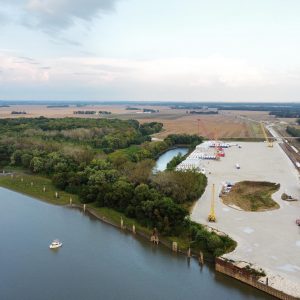
Marinas love covered slips
Maybe there are covered slips on other parts of the trip, but we haven’t noticed. Since leaving Chicago, almost every marina we’ve stayed in looks like a parking garage for boats. It’s a little tougher getting up in the morning without natural sunlight coming through our hatch, but being protected from the rain has been pretty nice.
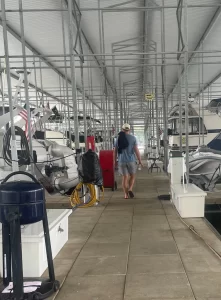
Barges move much slower
Great Lake freighters are massive and carry everything from coal, grains, chemicals, and more to and from inland waters to the ocean. While they seem to be large and cumbersome, they move 3-4 mph faster than us, so we tried to always stay out of their way. This wasn’t hard because, well, the Great Lakes are pretty large.
Similar cargo is carried on the rivers but via towboats with huge barges in tow up and down the waterways. These massive blocks move much slower, at around 4-5 mph, and wind their way through much narrower channels. Due to the more confined waterways of the rivers, they also can sometimes take up the whole channel—especially on a curve.
So we always hail them on the radio to request to pass, but even how you communicate to pass barges is unique. There is no “pass on the right” or even “pass on the starboard”. Directions are given by either saying pass on the 1 or the 2—and yes—we have to refer to our chart more times than we’d like to admit.
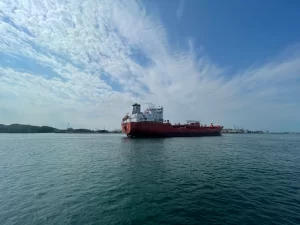
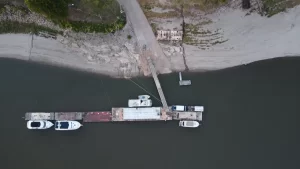
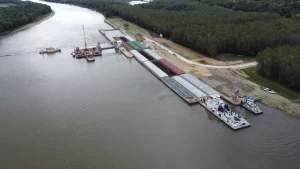
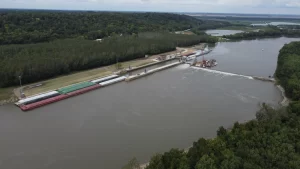
Depths can vary significantly
The rivers were historically low during our journey—due to lack of rainfall—which poses its own challenges. Several anchorages were inaccessible and channels were narrower. When the rivers are high, it causes other issues, such as making it difficult for barges to clear bridges and the rivers become more prone to flooding. (The floods are a whole different story—check out photos from The Great Flood of 1993).
When we read anchorage reviews, we always had to take into account what the water levels were that year. Luckily, we’ve had two great briefings by dock masters—at Heritage Harbor in Ottawa, Ill. and Hoppies in Kimmswick, Mo.—to give us some local knowledge to help us plot our routes.
The current is real
The Mississippi River current runs around 2-3 knots (~3 mph) which means Sweet Day can get some miles down sipping on little fuel. But it also means the river can carry a lot of crap, and especially after rain, it’s not uncommon to see whole tree trunks floating down the river. On the Ohio, we travel up the river a bit, going against the current, making our our engine work a little harder—so it all evens out.
The Erie Canal and river locks are different
We’ve done our fair share of locks through the Erie Canal, but the river locks are a whole different game. They are built and primarily used for commercial cargo, and as a result, they are bigger, operate differently, and pleasure boats—rightfully so—pass through only in between commercial traffic, sometimes causing long wait times.
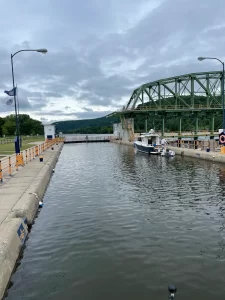
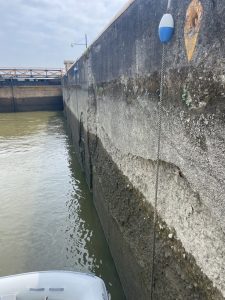
A lot of things would come to a halt without the rivers
Roughly 119 million tons of commodities are transported on the Mississippi River every year. Everything from grain, oil, orange juice, coal, salt, gravel, and more move up and down the river through barges that load and unload from countless quarries, plants, and loading docks scattered along the rivers’ edges. According to the National Parks Service, 60% of all grain exported from the US to the rest of the world comes down the Mississippi. It takes only 1 gallon of fuel for a tow to move a ton 647 miles—way more efficient than a truck transporting goods on a highway. Being able to see this up close every day, puts into perspective the incredible amount of work it takes to move goods around our world, and how critical maintaining navigable depth and working infrastructure is to the river’s viability.
Bald Eagles became the new dolphins
One of the best parts of traveling up the East Coast is the daily dose of dolphins. Seeing one never got old and we would always—because we couldn’t help it—announce with enthusiasm when we saw them near Sweet Day. Bald Eagles are the equivalent of the rivers. While we’re partial to dolphins, our daily sightings of eagles still end up getting a similar amount of attention. You just can’t help but watch them soar and feel in awe of their presence.
The rivers are a lot of fun too
While they have their own things to watch out for, we’ve had a lot of fun times—and we still had several hundred miles left of rivers to cruise!
- Danced the night away at Lobster Boil Night at Ivy Yacht Club in Peoria, Ill.
- Ate fall-off-the-bone ribs, climbed a crazy jungle gym, and rode the Arch in St. Louis
- Entered a drawing to win $250 cash from the bar we tied up to outside Joliet for the night (we didn’t win)
- Ate the infamous Levee-high apple pie at Blue Owl Bakery
- Hiked around Illinois’ most visited state park at Starved Rock State Park
- Celebrated our 2nd anniversary with some incredible bread pudding at Grafton Oyster Bar
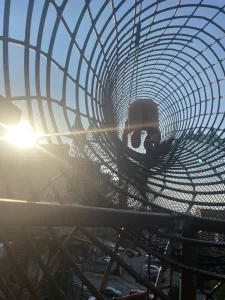

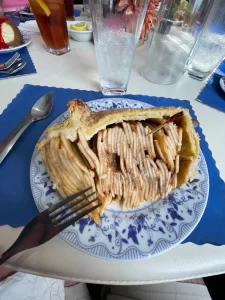



For a look at more of the adventures of “Sweet Day”, check out their blog here: https://www.lifeonsweetday.com/



